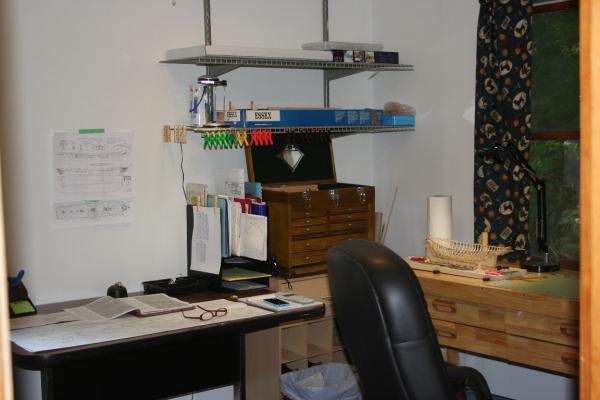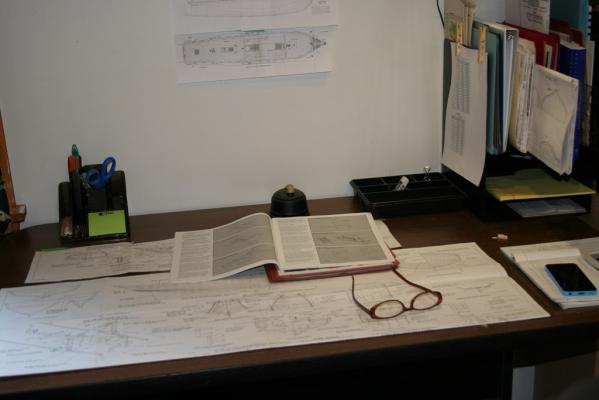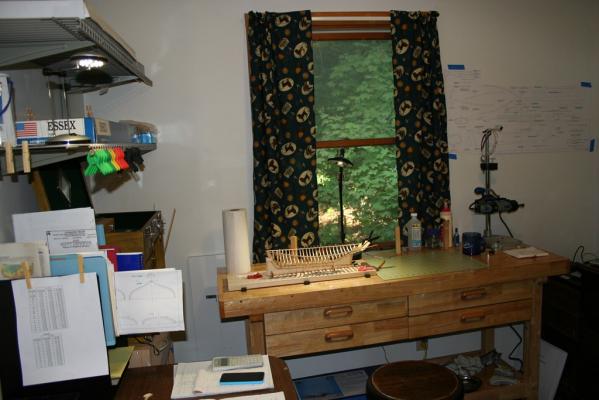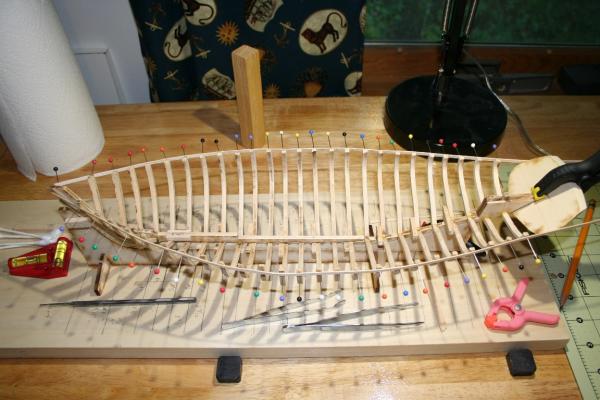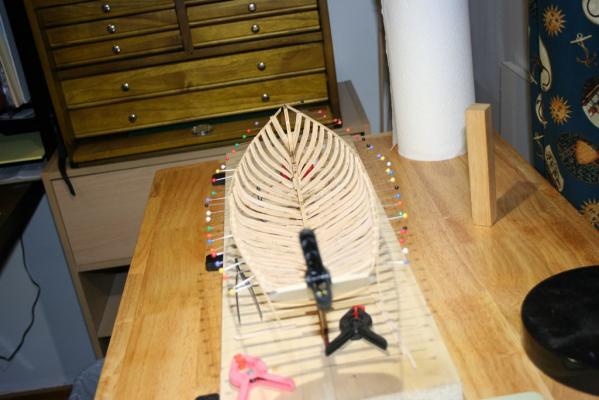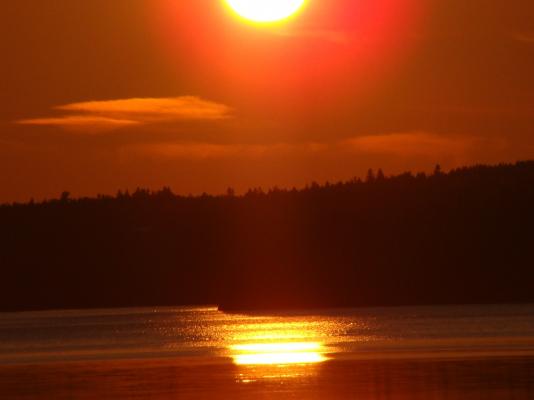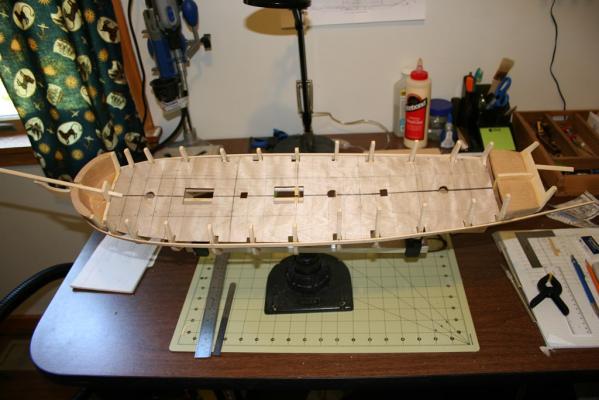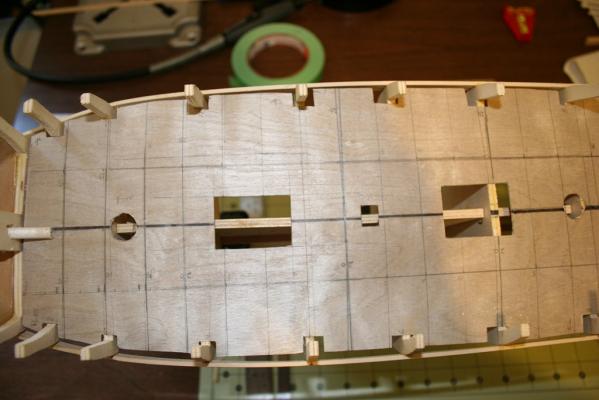-
Posts
3,156 -
Joined
-
Last visited
Content Type
Profiles
Forums
Gallery
Events
Everything posted by trippwj
-
Gracious, Mobbsie - them's a heap of lines to keep track of! Not much I can contribute here, other than admiring ur work!
- 1,279 replies
-
- agamemnon
- caldercraft
-
(and 1 more)
Tagged with:
-

Announcing the Model Ship World Ship Kit Database Project
trippwj replied to SkerryAmp's topic in Wood ship model kits
Looks good, Adam. As to plans, are you able to index other site search engines? For example, the NMM for primary source plans in the UK (hundreds of plans - thousands of sheets). Others are tougher - Smithsonian is great but no list - need to buy the catalogues. Also have the Mystic Seaport Museum, Lenthall collection in Pennsylvania (PDF catalogue), then several other libraries and museums, before we start with the commercial entities not affiliated with kit manufacturers (sellers of MacGregor, Underhill, and other 20th century draftsmen, for example, not to mention Maryland Silver Company, Taubmann's, and many more). -
Congratulations, Ulli. The Phantom is a nice little build. The good news, I suppose, is that at least for the early stages, most of what you will be doing is light carving and sanding as you shape the hull. While it can get messy, it is nothing a good vacuum won't clean up, and doesn't require a great deal of space! Take your time on the shaping - the dividends from careful attention at this step are huge as you progress! Enjoy, and I will pull up a seat and follow along - I have 2 of these on the shelf needing some attention (one for each boy). Hopefully Sjors will bring his popcorn and Mark will bring the beer.
-
I had not seen that this one came out - looks like it may be an interesting addition to my library! The Masting of American Merchant Sail in the 1850s: An Illustrated Study William L. Crothers – July 2014 Paperback: 188 pages Publisher: McFarland (July 31, 2014) Language: English Print ISBN: 978-0-7864-9399-9 Ebook ISBN: 978-1-4766-1569-1 57 illustrations, 2 maps, appendix, glossary, bibliography, index 188pp. softcover (8.5 x 11) This book describes the intricacies of the construction and fabrication more than 150 years ago of masts and yards installed in American merchant vessels, particularly those spars which were "built" or composed of multiple pieces bound together by iron bands. These were referred to as "made" spars as opposed to spars constructed from a single tree. It also contains instructions for developing the shape and proportions of various spars. Very little information is available on this subject. Generally, the external sizes of individual spars can be found but intimate details are sorely neglected. In addition, the book includes the spacing and location of masts in a ship, and the rake, and it discusses the types of wood that are most desirable in the construction of spars. Table of Contents Acknowledgments vi Preface 1 Introduction 3 Alphabetical List of Vessels 6 Chronological List of Vessels 10 Part I. How Masts and Spars Were Constructed 1. The Evolution of Masts and Spars for the Square Rigged Vessel 25 2. Timber Used in Mast Making 32 3. Harvesting, Storage and Preservation of Timber 34 4. Proportions of Masts and Spars 41 5. A Single Tree Mast and Bowsprit 52 6. Made-Masts and Made-Bowsprits 57 7. Upper Masts 75 8. Yards 82 9. Booms and Gaffs 92 Part II. Masting Arrangements 10. Location and Rake of Masts 99 11. Spar Plans of American Merchant Sail in the 1850s 103 12. The Spar Makers 124 Appendix: Masting Tables for Categories of Vessels Included in This Book 127 Glossary 173 References 177 Index 179 Publisher website: http://www.mcfarlandbooks.com/book-2.php?id=978-0-7864-9399-9
-
VERY nice looking start, Sjors. The lines and curves look about right to me!
- 1,616 replies
-
- caldercraft
- agamemnon
-
(and 1 more)
Tagged with:
-
The article can be found here http://modelshipworldforum.com/ship-model-masts-and-yards.php
-
Well, after having the summer to relax, the Emma C. Berry has come back to the build table. She was getting a mite snippy sitting on the shelf in my business office. Prior to resuming work, took a ride to Bangor yesterday to pick up a Harbor Freight work bench - the Admiral and son the elder helped get it set up. After a bit of organizing this morning, have removed the temporary battens that I glued on (not the brightest thing I have ever done) and replaced with pins. Also have beveled and installed the transom. Next step is to fine tune the tops of the frames (a couple are just a smidge long or short - fortunately they get covered by the covering board and are hidden) then prepare and install the clamps. From there, into the building of the interior - that should take quite some time! Profile view View from the stern A quick tour of the reorganized shop. Many thanks!
-
Gorgeous! Fantastic! OK - not too bad at all. Looks wonderful, Augie - the scarphs are a nice detail.
- 2,191 replies
-
- confederacy
- Model Shipways
-
(and 1 more)
Tagged with:
-
From 1941 to 2002, The American Neptune was America's premier journal of maritime history and arts. The journal's articles, written with clarity and scholarly substance, are of interest to all who enjoy accounts of ships, the seas, and those who've sailed them - for mercantile gain, their nation's interest, or the love of voyaging and exploration. They cover a wide range of subjects (art and artifacts, people, events), geographical areas (American and international) and time periods (prehistory through modern day) and were written for scholars, professionals and enthusiasts. The journal, founded by a group that included Samuel Eliot Morison and Walter Muir Whitehill, was issued as a quarterly (Winter, Spring, Summer, Fall). I have been looking for various past issues of the journal, and found today that the Peabody Essex Museum has begun to post ditized PDF copies of the journal in the Phillips Library Digitial Collections at http://phillipslibrarycollections.pem.org/cdm/landingpage/collection/p15928coll3 Currently Volumes I, II and II are posted (1941 through 1943), with the first 2 issues for Volume IV also posted (1944). The Phillips Library is the documentation and research division of the Peabody Essex Museum in Salem, Massachusetts. The collection presents a detailed account of the global nature of commercial outreach by Essex County residents in the 18th and 19th centuries during the “golden age” of shipping. Logbooks, merchant account books, shipbuilder’s records, customhouse records, and documentation of travels and exploration to the Pacific can all be found within its print and manuscript collections. At one time, Salem was the largest trading port on the east coast. Logbooks in the collection document the relationship between Salem and Japan as early as 1799. China trade is also represented through manuscripts found in the collection and by the Frederick Townsend Ward print collection, one of the world’s largest collections of Western-language materials on Imperial China.
-
Good morning, popeye. Took 2 tries to get it looking the way I wanted, but not too shabby a false deck. The inner bulwarks will be planked, with a waterway for transition to the planked deck. The lines on the false deck are my guides for when I plank it - they are about 4 scale feet apart based on the info in the Anatomy of the ship and the Frigate Essex Papers.
-
Author: Charles Derrick Published 1806 Description from Cambridge University Press: “Following the British naval successes of the early French Revolutionary Wars, which culminated in the Battle of Trafalgar in 1805, public interest in the history and growth of the Royal Navy increased dramatically, inspiring the publication of scholarly works relating to naval history. This volume, written by Naval Office clerk Charles Derrick and first published in 1806, contains a detailed account of the changes in the state of the Royal Navy between 1485 and 1805. Derrick focuses on the decline and growth of the number of ships in the Navy during the reign of each monarch through this period, listing the number of ships and tonnage at the start of each reign and describing innovations and new ships built during the period. Including copies of contemporary naval reports on ship numbers, tonnage and shipbuilding techniques, this clear and concise study remains a valuable reference for the study of naval history.” Download available at: http://books.google.com/books?id=3CoVAAAAQAAJ Purchase printed reproduction ($42.99) at: http://www.cambridge.org/us/academic/subjects/history/military-history/memoirs-rise-and-progress-royal-navy In addition to numerous listings of the ships in service (including, for many, their principal dimensions and number of men in the crew), there are several appendices wherein various dimensions from the Establishments of 1677, 1691, 1706, 1719, and 1745, as well as the proposals from 1733 and 1741 are listed. Additional tables show the weights of bower anchors and cables for various establishments (page 266), and dimensions of cannon and the guns (number and weight) from various periods. Note that this is the source used in the 1860 Encyclopedia Britannica article on Shipbuilding.
-
Gracious - time has certainly flown by this summer! Not a huge amount of rogress to report. Have been far too busy doing things with the family when not working the paying job. Alas, that is all coming to an end. Brought my "other son" back to Arkansas this week - up side there was I got to see the other two grandkids! Son the elder leaves the nest (well, sort of) tomorrow - off to college he goes. Living on campus - not sure how we will handle not having any kids in the house (first time in 20 years). Anyway, have cut out the openings in the gun deck for masts and gratings and installed the false deck into the hull. Centerline aligns well, and the openings match the plans well. So, at least until the end of September, the Essex will go into ordinary and the Emma C. Berry will move back onto the build table. Thanks, all, for the kind words and for following along - see you over at the ECB build log!
-
Sjors - Here I am, 3 days left in my vacation, and you are preparing for another week off?? I want to work for your company - do they need drivers in Maine?? Pfffffffffffffffff Good decision on re-doing the copper plates. Will wait (patiently) for the next pictures. All the best-
- 1,616 replies
-
- caldercraft
- agamemnon
-
(and 1 more)
Tagged with:
-
I'm getting confused now. Both your build and those photo's from Bruno are DEFINITELY "eye candy"!!!
-
Beautiful work, Kevin. Ignore Sjors - to him, any non Dutch vessel is a fishing trawler! Interesting plan you have for display - will you be carving the crew or recruiting?
- 1,319 replies
-
- caldercraft
- Victory
-
(and 1 more)
Tagged with:
-
Nice start, Sjors. You should be about done with the copper plates on her when I am ready for you to put the copper plates on my Essex!!!
- 1,616 replies
-
- caldercraft
- agamemnon
-
(and 1 more)
Tagged with:
-
Hello, Mobbsie - thanks for stopping by! There is actually only one that is a bit off - the battens are not placed really neatly - just to lend support for when i start working on the innards. I think I will need to trim the tops of a couple of frames but the overall flow works pretty well. i do need to work with the crew on reading the tide. Unfortunately, it comes in at a rate of about 1 foot in 15 minutes in that area, so they misjudged somewhat. One of the crew actually went for a swim - had to go out and get him before he headed to Canada on the tide! Greetings, Lawrence. I think most of the frames will fare in pretty well - those are just temporary battens to give some rigidity to the frames when i start working inside the hull. When I run the battens along the planking lines they fare in nicely. She is actually a fairly sharp bowed vessel.
-
I have been using it for about 2 years now and love it - each update adds a bit more functionality. Easy to enter data, easy to search, just need to keep it hidden from the spouse so she doesn't know how much I have invested in books I also added a couple of custom types so that I can track my downloaded (PDF) files using the program. MUCH easier than the spreadsheets I started out with!
-
Just to liven things up (so to speak), here are two excerpts from Alexander D. Fordyce: Outline of Naval Routine (1837) http://books.google.com/books?id=vPANAQAAMAAJ RATLING RIGGING (pages 45 - 46) Girt out the Rigging with a Fore and Aft Swifter, but not very much out of the straight line; then spar it down with spare Spars, Studding-sail Yards, Boat's Oars or Hand-spikes, all seized on carefully square. Nettle-stuff made from Bolt-rope Yarns, or something equivalent, is very necessary for seizing the Ratlings with; and, if new, it ought to be well and carefully stretched previous to cutting. The best Seizing-stuff should be preserved till the new Ratlings have been a little worn. Fourteen or sixteen inches is a good distance between the Ratlings, and their places should be calked off all the way up and down before commencing. Each man employed should have a measure within his reach, and special care should be taken to make the Ratlings of the one side correspond in parallel direction with those of the other. This can only be seen from outside. Make the Hitches neat, Eyes small, and Ratlings square one with the other. Few things tend more to snug appearance. If the Rigging is to blacked after Ratling down, it is best to leave the Spars on till that is done; but if the Rigging is not to be blacked, the Spars may be taken off as the new Seizings are finished and blacked. BLACKING RIGGING. (pages 46-47) When blacking new Rigging for the first time, the best mixture will perhaps be found to be Stockholm Tar, Coal Tar, and Salt Water, in equal proportions, and heated up in the Fish Kettle, over which a Sentry should be placed. After the first blacking, half the quantity of Stockholm Tar is sufficient; Coal Tar alone being always used for the Yards and Bends. The most convenient method of Blacking Rigging is with Top-gallant Masts on deck, but Royal and Top-gallant Rigging placed at Mast-heads; for the men who ride down and black the Topmast Stays, can then at the same time black the Topgallant and Royal Stays handily; or, what is handier still, men at the Mast-head haul over and black these small Stays, and pay them down forward when done; the men, also, who black down the Topmast Backstays, can carry on at the same time with Topgallant and Royal Backstays. In addition to all which, the Masts are kept clean. If, on the other hand, Top-gallant Masts be kept up when Blacking, the Small Stays and Backstays must be let go, in order that they may be got at by the men on the Topmast Stays and Backstays; consequently, the Masts must be adrift, and exhibit a specimen of slovenliness unbecoming a Man-of-War. The Masts will, moreover, be daubed over with Blacking; and if it come on to blow so as to render it necessary to get Topgallant Masts on deck before the Rigging be dry, much injury must result to the Blacking. Previous to commencing, the Decks should be well sanded, and the Paint-work and Figure-head carefully covered with old Canvas and Hammocks. The Quarter Tackle should be clapped on one side of Main Yard, and a Burton on the other, ready for Provisioning and Clearing Boats. The Hammocks should also be covered, and the Quarter Boats lowered out of the way. The finer and warmer the day, the better. The Blacking will lay on so much the smoother and thinner; but commencement should be delayed till the dew is well dried off. Topsail and Lower-lifts should be blacked first; the men having to stand upon the Yards to do them. A smooth, calm day is required for the Bends ; for the Blacking will not take effect, unless the surface it is laid upon be dry.
-
Looks sweet! Umm, are those cannon balls I see? I thought you were using cotton balls?????
- 1,873 replies
-
- occre
- san ildefonso
-
(and 1 more)
Tagged with:
About us
Modelshipworld - Advancing Ship Modeling through Research
SSL Secured
Your security is important for us so this Website is SSL-Secured
NRG Mailing Address
Nautical Research Guild
237 South Lincoln Street
Westmont IL, 60559-1917
Model Ship World ® and the MSW logo are Registered Trademarks, and belong to the Nautical Research Guild (United States Patent and Trademark Office: No. 6,929,264 & No. 6,929,274, registered Dec. 20, 2022)
Helpful Links
About the NRG
If you enjoy building ship models that are historically accurate as well as beautiful, then The Nautical Research Guild (NRG) is just right for you.
The Guild is a non-profit educational organization whose mission is to “Advance Ship Modeling Through Research”. We provide support to our members in their efforts to raise the quality of their model ships.
The Nautical Research Guild has published our world-renowned quarterly magazine, The Nautical Research Journal, since 1955. The pages of the Journal are full of articles by accomplished ship modelers who show you how they create those exquisite details on their models, and by maritime historians who show you the correct details to build. The Journal is available in both print and digital editions. Go to the NRG web site (www.thenrg.org) to download a complimentary digital copy of the Journal. The NRG also publishes plan sets, books and compilations of back issues of the Journal and the former Ships in Scale and Model Ship Builder magazines.



